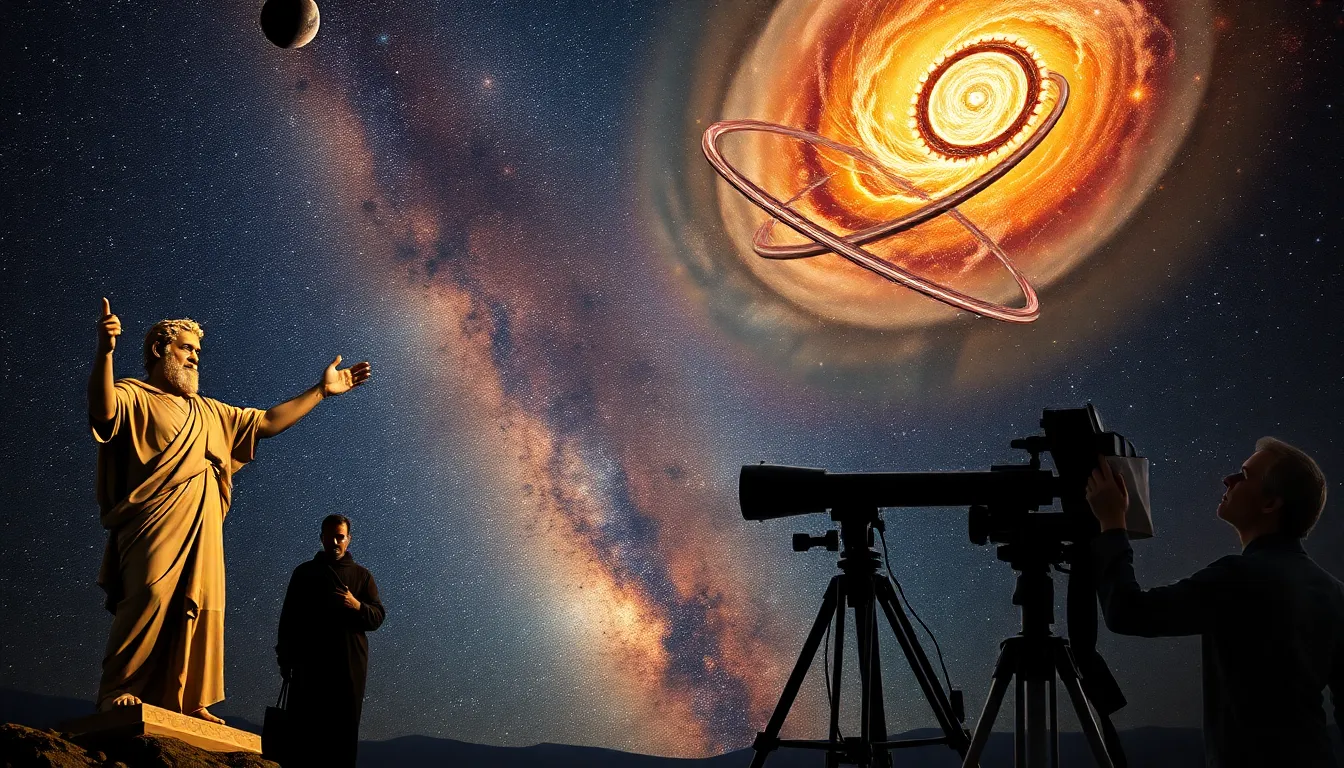Table of Contents
ToggleCosmology studies the universe’s origins, evolution, and ultimate fate, captivating scientists and enthusiasts alike. It’s a field that delves into the mysteries of space, time, and the fundamental laws that govern everything around us. By examining celestial phenomena and cosmic events, researchers unveil the intricate tapestry of the cosmos.
In recent years, advancements in technology have propelled cosmology into new realms of discovery. From the cosmic microwave background radiation to the exploration of dark matter and dark energy, each breakthrough adds depth to humanity’s understanding of the universe. As questions about the cosmos persist, the quest for knowledge continues to inspire curiosity and innovation in this ever-evolving discipline.
Overview of Cosmology Studies
Cosmology studies encompass the scientific examination of the universe’s origins, structure, and eventual destiny. Researchers analyze various phenomena and concepts to unravel the secrets of space and time. Central topics include:
- Big Bang Theory: The leading explanation for the universe’s inception, proposing it began from a singularity and expanded over 13.8 billion years.
- Cosmic Microwave Background Radiation: This faint afterglow from the Big Bang offers vital clues about the universe’s early conditions and supports the Big Bang Theory.
- Dark Matter and Dark Energy: These enigmatic components account for approximately 95% of the universe’s total mass-energy content. Dark matter influences galaxy formation, while dark energy drives the cosmos’ accelerated expansion.
- Structure Formation: Researchers study how galaxies, clusters, and large-scale structures evolve. This field includes the examination of cosmic webs formed by gravitational interactions.
Instruments like telescopes and satellites, such as the Hubble Space Telescope and the European Space Agency’s Planck satellite, play crucial roles in cosmology studies. They capture detailed images and data, enriching our comprehension of celestial objects and phenomena.
Interdisciplinary collaboration enhances cosmological research, merging insights from physics, astronomy, and mathematics, thus fostering innovative approaches to cosmic questions. As technology advances, cosmology evolves, continuously expanding the frontier of scientific knowledge.
Historical Development of Cosmology

Cosmology has evolved from ancient interpretations of the universe to complex scientific theories, reflecting humanity’s quest to understand existence. Key milestones mark this journey, showcasing the shift from philosophical musings to data-driven research.
Ancient Cosmology
Ancient civilizations laid the groundwork for cosmological thought.
- Babylonians developed a geocentric model, placing Earth at the center of the universe, surrounded by stars and planets. They recorded astronomical observations on clay tablets, influencing future scholars.
- Greeks, particularly thinkers like Ptolemy, further refined the geocentric model through sophisticated mathematical systems, employing epicycles to explain planetary motions. This approach dominated for centuries.
- Aristotle introduced the concept of a spherical Earth and proposed that celestial bodies moved in perfected circular paths. His philosophy influenced medieval thought and the Catholic Church’s teachings.
Modern Advances in Cosmology
Modern cosmology shifted dramatically with scientific revolution milestones.
- Copernicus proposed the heliocentric model in the 16th century, positioning the Sun at the center of the solar system and challenging long-held beliefs.
- Galileo Galilei utilized telescopic observations to support Copernicus’ theory, discovering Jupiter’s moons and the phases of Venus. This evidence bolstered the heliocentric perspective.
- Newton formulated the law of universal gravitation, unifying terrestrial and celestial mechanics, laying a foundation for further astronomical studies.
- Einstein’s General Relativity revolutionized cosmological thought in the early 20th century, illustrating how mass and energy shape spacetime, and introducing concepts such as black holes and gravitational waves.
- Hubble’s work in the 1920s revealed that the universe expands, leading to the formulation of the Big Bang Theory as a leading explanation for cosmological evolution.
These advancements continue to fuel research, enhancing understanding of the cosmos through technologies like the Hubble Space Telescope and the Planck satellite, which capture essential data about cosmic events. Thus, the field of cosmology remains an active and vital area of inquiry within science.
Key Concepts in Cosmology Studies
Cosmology encompasses several fundamental concepts that enhance understanding of the universe’s nature and behavior. Key ideas such as the Big Bang Theory, dark matter, and dark energy play crucial roles in shaping modern cosmological research.
The Big Bang Theory
The Big Bang Theory describes the universe’s inception from a singularity approximately 13.8 billion years ago. It asserts that the universe has continuously expanded since this initial explosion. Astronomical observations, including the detection of cosmic microwave background radiation, provide substantial evidence for this theory. This radiation represents the afterglow of the early universe, affirming the conditions postulated by the Big Bang. The theory also explains the abundance of light elements, such as hydrogen and helium, aligning with predictions from nuclear processes occurring shortly after the initial expansion.
Dark Matter and Dark Energy
Dark matter and dark energy constitute roughly 95% of the universe’s mass-energy content, significantly influencing its structure and fate. Dark matter, an invisible substance, does not emit light but interacts gravitationally with visible matter, gas, and radiation. Its presence explains discrepancies in galactic rotation curves and the formation of large-scale structures in the universe.
Dark energy, on the other hand, accounts for the accelerated expansion of the universe. It acts as a repulsive force countering gravitational attraction, making up about 68% of the universe. Observations of distant supernovae and large-scale surveys of cosmic structure support the existence of dark energy, showcasing its critical role in cosmology. Understanding both dark matter and dark energy remains a primary focus for cosmologists, driving advanced research and innovative methodologies in the quest to decode the universe’s mysteries.
Methods and Techniques in Cosmology
Cosmology relies on various methods and techniques to investigate the universe’s vast complexities. These approaches include observational techniques and theoretical models that collectively enhance the understanding of cosmic phenomena.
Observational Techniques
Observational techniques form the backbone of cosmology, providing data to test hypotheses and validate theories. Key methods include:
- Telescopic Observations: Telescopes, like the Hubble Space Telescope and upcoming James Webb Space Telescope, capture light from distant celestial objects. They allow scientists to analyze the composition, age, and distance of galaxies.
- Cosmic Microwave Background Measurements: Satellites such as the Planck satellite measure fluctuations in cosmic microwave background radiation. These measurements yield insights into the early universe’s conditions, supplying evidence for the Big Bang Theory.
- Spectroscopy: Spectroscopy analyzes light from astronomical sources to determine their chemical composition, temperature, and velocity. This technique reveals crucial information about star formation and galaxy dynamics.
- Large-Scale Surveys: Surveys like the Sloan Digital Sky Survey map millions of galaxies, providing statistical data on their distribution. These surveys assist in understanding large-scale structure formation and the influence of dark matter.
- Gravitational Lensing: This technique observes how massive objects bend light from distant galaxies. Gravitational lensing helps quantify dark matter’s presence by assessing the effects of gravity on light paths.
Theoretical Models
Theoretical models serve to interpret observational data and predict cosmic phenomena. Essential models include:
- Lambda Cold Dark Matter (ΛCDM) Model: This standard model depicts the universe’s structure and evolution, incorporating dark energy and cold dark matter as primary components. It aligns with observations of cosmic microwave background radiation and galaxy distribution.
- General Relativity: Einstein’s theory describes gravity as a curvature of spacetime. This framework predicts the behavior of galaxies and cosmic structures under the influence of gravity.
- Inflationary Theory: This model proposes a rapid expansion of the universe shortly after the Big Bang. It explains the uniformity of cosmic microwave background radiation and the distribution of galaxies.
- Deep Learning and Simulation Models: Advanced computational techniques utilize machine learning and simulations to replicate cosmic phenomena. These models test various scenarios and refine understanding of structure formation and evolution.
- Anisotropic Models: These models account for variations in the universe’s expansion rate across different directions. They aid in exploring implications of dark energy and topological features of the cosmos.
Each method and model enhances the study of cosmology, providing vital insights into the universe’s origins, structure, and fate.
Current Trends in Cosmology Studies
Current trends in cosmology studies reflect an expanding understanding of the universe through innovative research and technology. Key areas of focus emerge as scientists strive to unravel cosmic mysteries.
Emerging Research Areas
Emerging research areas in cosmology include gravitational wave astronomy, primordial black holes, and the role of quantum mechanics in the early universe. Gravitational wave astronomy studies the ripples in spacetime caused by massive cosmic events, such as black hole mergers, enhancing knowledge of the universe’s violent phenomena. Primordial black holes, hypothesized to form in the early universe, offer insights into dark matter and cosmic structure formation. Additionally, the intersection of quantum physics with cosmology prompts investigations into the conditions of the universe’s infancy, impacting theories of inflation and cosmic evolution.
Technological Innovations
Technological innovations play a crucial role in advancing cosmology studies. Instruments like the James Webb Space Telescope (JWST) and large ground-based observatories, such as the European Extremely Large Telescope (E-ELT), enhance observational capabilities. These technologies enable detailed studies of distant galaxies, exoplanets, and cosmic background radiation, revealing previously hidden details of the universe. Furthermore, AI and machine learning techniques improve data analysis from surveys, efficiently processing vast amounts of information to identify significant cosmic patterns and anomalies.
Future Directions in Cosmology Studies
Future directions in cosmology studies focus on advancing technology and enhancing theoretical models to deepen understanding of the universe. Key areas of exploration include:
- Gravitational Wave Astronomy
Gravitational wave astronomy studies ripples in spacetime resulting from massive cosmic events, such as mergers of black holes and neutron stars. This research provides insights into extreme environments and tests general relativity under strong gravitational fields.
- Primordial Black Holes Research
Primordial black holes, formed shortly after the Big Bang, serve as potential candidates for dark matter. Investigating these phenomena aids in understanding both dark matter’s nature and the early universe’s conditions.
- Cosmic Inflation
The study of cosmic inflation examines the rapid expansion of space during the early universe. This area continues to attract attention, as researchers aim to identify observational evidence, connecting inflation with cosmic microwave background fluctuations.
- Interdisciplinary Approaches
Collaborations among physicists, astronomers, and data scientists enhance cosmological studies. Interdisciplinary techniques improve data analysis through machine learning and advanced computational simulations, refining predictions and validating models.
- Dark Energy Investigations
Continued exploration into dark energy remains critical, as it constitutes approximately 68% of the universe. Understanding its properties may unlock answers regarding the accelerated expansion of the universe and its ultimate fate.
- Exoplanet Studies
Exoplanet research intersects with cosmology, offering insights into planetary formation and potential habitability. Investigating distant worlds enhances comprehension of the universe’s diversity and the conditions for life.
- Next-Generation Telescopes
The implementation of next-generation telescopes, like the James Webb Space Telescope, aims to revolutionize observational capabilities. Their sensitivity allows for probing distant galaxies, star formation, and the chemical composition of exoplanets.
- Quantum Gravity
Research into quantum gravity addresses the integration of quantum mechanics and general relativity. This field seeks to unify these two frameworks, possibly unveiling new aspects of spacetime and the universe’s origins.
These future directions in cosmology studies highlight the commitment to uncovering cosmic mysteries and pushing the boundaries of human knowledge. Each exploration contributes to the expansive tapestry of understanding the universe.
The field of cosmology continues to evolve as researchers push the boundaries of human understanding. With each technological advancement and theoretical breakthrough, new mysteries of the universe unfold. The interplay between dark matter, dark energy, and the universe’s expansion remains a central focus, driving innovative research and interdisciplinary collaboration.
As scientists explore gravitational waves and primordial black holes, they pave the way for future discoveries that could reshape our comprehension of the cosmos. The commitment to unraveling these cosmic enigmas ensures that cosmology will remain a dynamic and inspiring field, captivating the minds of both scholars and enthusiasts alike. The journey to uncover the universe’s secrets is far from over, and the excitement of what lies ahead is palpable.







